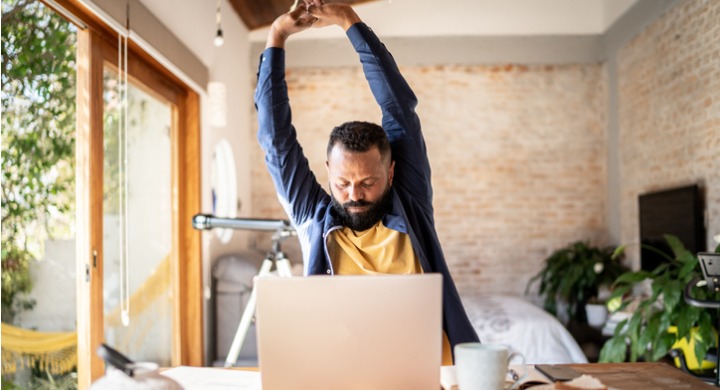
Laptops can be one of the most convenient pieces of equipment in our working lives. While the convenience factor certainly makes our lives simpler we often don’t see past this to consider the poor ergonomics of a laptop. Changing your laptop setup doesn’t need to be a time consuming or expensive exercise, however the benefits are well worth it. Find out how you can use a laptop so that you aren’t risking an injury or poor posture.
Using a Laptop at a Desk
The average adult’s height means they can’t use a laptop on a desk in an ergonomically correct position without additional equipment, and you don’t need expensive equipment to improve the ergonomics of your laptop setup.
Laptop and Desk Set-up
Placed on a work surface a laptop screen is usually too low causing you to crane your neck or even lean into your laptop. Start by positioning yourself correctly in your chair - sit with a straight spine with your lower back supported by a great ergonomic chair keeping your shoulders back and feet flat on the floor. If your chair height has been adjusted to ensure a nice seated position & your feet are unsupported employ a foot rest. Read about the importance of using a footrest.
Now you will be able to determine how far away your laptop should located. Ideally the screen should be positioned about an arms length from you. Of course glasses or bi-focals may impact on this so adjust accordingly. Now you can adjust the height of the laptop, using a laptop stand, lift the screen so your eyes are looking in the top ⅓ of your screen or about 5-10 cm below the top edge of the screen and the centre of the screen is around 17cm below eye level. Eyes see more below the horizontal point than above so this position gives you the best field of view. The screen should be straight at a 90 degree angle with the desk.
WIth your laptop now in a comfortable ergonomic position you will need a separate ergonomic keyboard to you keep hands and wrists are in a neutral position to reduce the chance of a repetitive strain injury. This is also the time to consider an ergonomic mouse.
Your work requirements may mean a laptop screen isn’t big enough so invest in one or two larger monitors and a docking station. If using this setup your laptop may become a mobile hard drive. Free up desk real estate & store it in a vertical laptop holder.
Sit, Stand & Move
For the best posture, try to alternate between sitting and standing. The aim is to activate different muscles throughout the day. To quickly & easily adjust your desk height invest in a standing desk converter or a complete sit stand desk. For the greatest benefit, break up extended periods of time in one position by moving - up, down and around.
Using a Laptop on Your Lap
By its very design & intention the argument that laptops were designed to be used on your lap is unquestionable, however there are better ways to use them.
Poor Posture
On those occasions when it's just unavoidable & you find your laptop in your lap, be conscious of your position. Can you position yourself so your neck & back is a bit straighter & upright? Try to open up your chest so you can breathe comfortably & deeply. Stop frequently & stretch.
Lift the Screen
The same principle applies as when you’re sitting at a desk. By lifting the screen, your neck isn’t in flexion & (hopefully) your shoulders aren’t so rounded. Can you use your laptop bag on your lap to raise your screen? Is there a cushion handy? It won’t achieve the perfect recommended height but any height increase has benefits. If you use your laptop on the couch or in bed regularly, look at buying a mobile working table that can be easily adjusted to suit your location.
Increase the Font Size
If you find yourself craning or leaning in to see the screen, increase the font size. Sure there might be more scrolling required but you will have a more relaxed posture if you aren’t struggling to see the screen. If you often work on spreadsheets or detailed documents, consider upgrading to a laptop with a bigger screen, or perhaps it is time to visit the optometrist!!
Take Regular Breaks
If you’re working from your lap, it’s even more important to take regular breaks. Your posture isn’t ideal so you need to get up and move around before putting the laptop back on your knee. When your focussed time flies & it’s easy to spend an hour or two with your laptop and forget to get up. Use your computer’s timer to remind you to take a break.
Changing your working position can also help with injury risk. With your laptop on a coffee or low height table If you are able to squat or kneel for 10 or 15 minute periods this will help improve hip mobility and reduce back compression.
Extra Accessories
If you are carrying your laptop between locations consider the weight of your laptop & all its accessories. Prevent the increased risk of a back or other injury & invest in a second set of accessories or store unnecessary items.
If you're looking for more clarity on how to practise good laptop ergonomics, or you'd like to discuss your specific business needs, don't hesitate to get in touch with Ergolink. Call us on (08) 9240 7066 or contact us online.